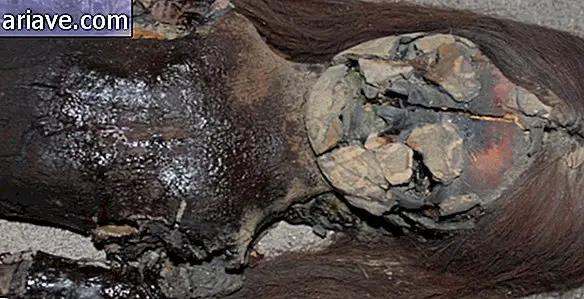10 fascinating festivals that are celebrated around the world
We are already on the eve of Carnival, which is undoubtedly among the largest and most popular festivities on the planet. However, there are many other celebrations out there - some more famous, some less so - that are beyond interesting, but that many people have never even heard of. With that in mind, we at Mega Curioso decided to get in the party mood and select 10 fascinating festivals for you to know. Check out:
1 - Songkran
Location: Thailand

Songkran is celebrated in Thailand annually between April 13 and 15 and coincides with New Year festivities from various South and Southeast Asian countries. During the celebration, real water battles take place in which participants soak each other in order to “wash away” all the evil in their lives.
2 - Día de los Muertos
Location: Mexico

Día de los Muertos is celebrated annually in Mexico from November 1st to 2nd - corresponding to All Saints 'Day and All Souls' Day - and all over the country there are parties beyond curiosity. In Mixquic, for example, there is a procession in which the inhabitants follow a coffin from the city center to the cemetery and, once there, spend the night awake by the candlelit tombs.
It is also common for banquets and street parties packed with dances and folk music to take place, and the image above shows a group of women produced for the festivities, which are especially popular in the cities of Merida and Aguascalientes - where the Calaveras Festival even takes place. every year between the end of October and the beginning of November.
3 - Holi
Location: India

The Holi, or Festival of Colors, is a lively Hindu celebration held in India annually. It takes place during Phalgun Purnima - a full moon that occurs in late February or early March - to celebrate the arrival of spring and serves to symbolize the triumph of good over evil.
4 - Elephant Festival
Location: Jaipur, India

Celebrated annually in Jaipur, India, the Elephant Festival takes place on the eve of Holi and thus also falls on the full moon during the Phalgun Purnima, which takes place between February and March. The festival is associated with the deity Ganesha, who, for Hindus, is one of the most revered and important figures of their religion, being responsible for removing obstacles from the path of the faithful.
The festival is marked by processions of horses, camels, dancers and, of course, elephants - who parade dressed and painted in vibrant colors and embellished with jewelry. The most beautiful copy of the parade is awarded, and in addition, activities such as elephant races and pachyderm polo games, as well as tug-of-war competitions in which the strongest animals are chosen and face groups of 19 are held. people.
5– Yi Peng
Location: Lanna Kingdom, Thailand

Also known as Yee Peng, this beautiful festival of light takes place in northern Thailand and is celebrated to show respect for Buddha. The party takes place during the full moon of the second month of the Lanna calendar - which usually falls in mid or late November, although exact dates vary annually. According to local belief, lanterns are released and carry with them, especially if they disappear from sight, bad luck and negative energy.
6 - Kukery
Location: Bulgaria

Celebrated since 2000 BC, the Kukery is a traditional Bulgarian festival in which participants perform a series of rituals in honor of the god Dionysus to ward off evil spirits. It takes place annually at the end of January for three days, and young boys take to the streets wearing colorful costumes and scary masks that often feature two features - one smiling and one threatening - to symbolize the coexistence of good and evil.
7 - Jaisalmer Desert Festival
Location: Rajasthan, India

Lasting three days, this interesting festival takes place annually in February in Jaisalmer, a city in the Indian state of Rajasthan. During the festivities, besides a lot of music, dance and regional food, there are polo games and camel races and competitions beyond curious, such as turban tying, which chooses the best mustache of the party and even that chooses Mr. Desert"!
8 - Els Enfarinats
Location: Ibi, Spain

Celebrated every year on December 28th, Els Enfarinats is a very messy festival taking place in the small town of Ibi, Spain. This date coincides with Día de los Santos Inocentes - Spanish version of April Fool's Day - and during the spree, the inhabitants dress in military, take control of the locality, declare a lot of absurd laws and even fine those who break the new ones. rules.
Then the participants face off in a fun epic battle in which they attack each other using flour and egg bombs and pop a bunch of firecrackers. And at the end of the “war, ” all money collected through fines is donated to Ibi charities.
9 - Boryeong Mud Festival
Location: Boryeong, South Korea

The Boryeong Mud Festival has been celebrated since the mid-1990s and began thanks to a cosmetics company campaign. Today, the event is two weeks long, and more than 2 million people participate in the activities - which include swimming pools and slides and even have a military training course in which aspiring cadets have to slip through the mud during various exercises. .
10 - Fallas
Location: Valencia, Spain

The Fallas are a traditional Valencian party that takes place in March, culminating in the 19th, that is, St. Joseph's Day. To understand what happens during the festivities, imagine a lot of samba schools (the Fallas ) whose members (the falleros ) assemble hundreds of sculptures (equivalent to floats) made mainly of wood and papier-mache - some more than 20 m high - mostly made up of satirical figures that had local and international prominence during the year and competing by the title of best of the year.
The festivities are also marked by various events, such as the mascletà - "simple" fireworks display of which you can see an example in the video above - the Nit del Foc, which corresponds to an expected fireworks show that takes place on the shores. from the Turia River, processions with flower offerings, voting for the best Falla of the year and finally Nit de la Cremà, when all the sculptures created by the Fallas are burned to the ground.











